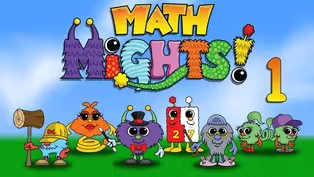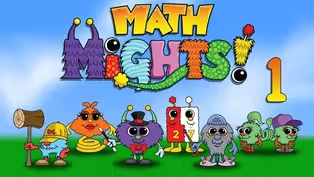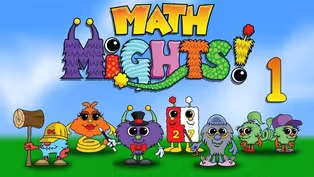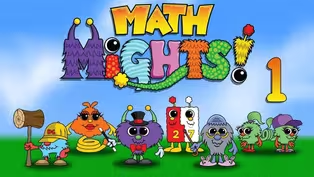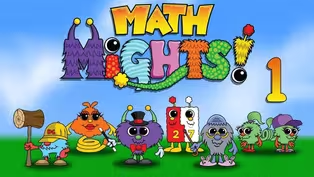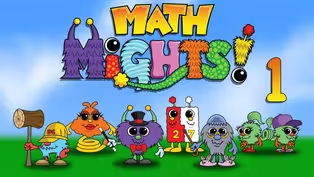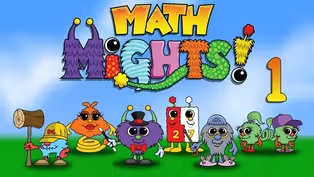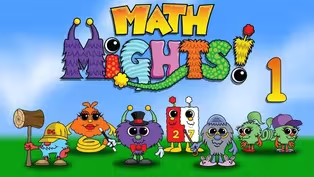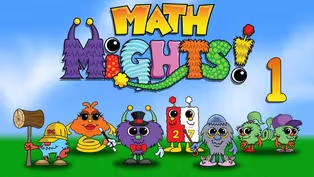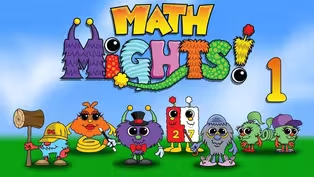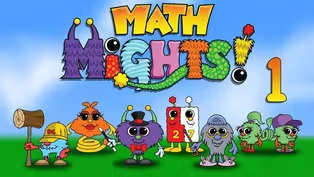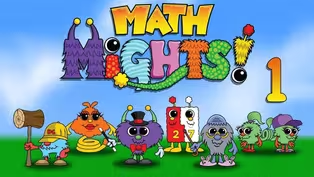Math Mights
Write Equations to Match the Strategy
Season 3 Episode 308 | 16m 2sVideo has Closed Captions
Join Mrs. Markavich for a missing addend word problem with Professor Barble.
Join Mrs. Markavich for a missing addend word problem with Professor Barble. Next we are going to look close at addition problems to see when we make a new ten or when we don't. You will be an expert and looking carefully at addition problems!
Problems playing video? | Closed Captioning Feedback
Problems playing video? | Closed Captioning Feedback
Math Mights is a local public television program presented by Detroit PBS
Math Mights
Write Equations to Match the Strategy
Season 3 Episode 308 | 16m 2sVideo has Closed Captions
Join Mrs. Markavich for a missing addend word problem with Professor Barble. Next we are going to look close at addition problems to see when we make a new ten or when we don't. You will be an expert and looking carefully at addition problems!
Problems playing video? | Closed Captioning Feedback
How to Watch Math Mights
Math Mights is available to stream on pbs.org and the free PBS App, available on iPhone, Apple TV, Android TV, Android smartphones, Amazon Fire TV, Amazon Fire Tablet, Roku, Samsung Smart TV, and Vizio.
Providing Support for PBS.org
Learn Moreabout PBS online sponsorshipMore from This Collection
Video has Closed Captions
Join Mrs. Markavich for a missing addend word problem with Professor Barble! (16m 5s)
Adding Tens-Tens and Ones-Ones
Video has Closed Captions
Join Mrs. Markavich for a missing addend word problem with Professor Barble! (15m 35s)
Video has Closed Captions
Join Mrs. Markavich for a subtraction word problem with Professor Barble. (15m 59s)
Video has Closed Captions
Join Mrs. Markavich for a missing addend word problem. (16m 6s)
Add 2-Digit Numbers & Write Equations
Video has Closed Captions
Join Mrs. Markavich for a word problem with her friend Professor Barble! (15m 59s)
Comparing Numbers Different Ways
Video has Closed Captions
Value Pak shows you the different ways to compare 2-digit numbers. (15m 44s)
Video has Closed Captions
Join Mrs. Markavich for a word problem with her friend Professor Barble! (15m 59s)
Video has Closed Captions
Join Mrs. Markavich for a word problem with her friend Professor Barble! (15m 59s)
Decompose/Compose #'s Different Ways
Video has Closed Captions
We show you different ways to decompose and compose 2-digit numbers! (15m 59s)
Video has Closed Captions
Join Mrs. Markavich & Dotson to talk about numbers with the Counting Buddy Senior! (16m)
Video has Closed Captions
Join Mrs. Markavich & Dotson for a Numeracy Talk with the Counting Buddy Senior (16m)
Video has Closed Captions
Join Mrs. Markavich for Numeracy Talk with Dotson working on conservation to 20. (16m)
Providing Support for PBS.org
Learn Moreabout PBS online sponsorship(playful music) - [Students] Math Mights!
- Hey, 1st Grade Math Mights.
I'm Mrs. Markavich, and I'm so excited that you're here with me today.
Let's check out our plan for the day.
Today, we'll solve a word problem with my friend, Professor Barble, then we'll write equations to match the strategy.
Let's warm up our math brain with my friend, Professor Barble, as he counters word problems.
Professor Barble loves to solve word problem, and if he slows down to look at what the question is really asking, and he presses on his cap, outcome, some very cool tools that will help him create a picture of what the problem is asking us.
You may ask yourself, what is a visual model?
Sometimes a visual model is known as a model drawing, a unit bar, a tape diagram, or a bar model.
Drawing a visual model helps us to visualize the strategies and understand what the word problem is asking.
A visual model is also a reading comprehension strategy for word problems.
This is a template we use in 1st Grade to help us with the visual model process.
Let's read our problem.
It says, in the morning there were eight leaves on the ground.
During the day, more leaves fell.
Now there are 13 leaves on the ground.
How many leaves fell during the day?
Well, my friend Rosa says, "I think maybe we should add to solve this problem."
But Gracie says, "Oh wait, do we subtract?"
Professor Barble says, "Whoa, hold on.
Let's slow down a little bit to see what the problem is really asking us."
He wants us to use a step-by-step visual model process to create a picture of what the problem is really asking.
So let's get started with those steps.
Step number one is to read the entire problem and put it into chunks.
We're going to do that together.
I'm going to read the sentence and chunk it, and then you're going to echo me.
Let's try it now.
It says, in the morning there were eight leaves on the ground.
Chunk.
The next part says, during the day more leaves fell.
Chunk.
Now there are 13 leaves on the ground.
Chunk.
How many leaves fell during the day?
Chunk.
Step two is that we rewrite the question in the sentence form with a blank space for the answer.
We do this so we know what we are solving for.
Mine says, hmm, hmm, fell during the day.
Step number three is to determine the who or what is involved in the problem.
Let's look at mine.
You can see on my part, it says who or what.
The what are the leaves.
Step number four is to draw the unit bar.
You can see that I've drawn the unit bar for you, and I helped you out today and put in the line for you.
Step number five is when we add the information and we go back and check it off as we add the chunks.
Let's do that together on mine.
In the morning, there were eight leaves on the ground.
We're going to go to the unit bar, we're going to add eight, and then I'm gonna label it.
It's really important to label it.
I'm going to put an m for morning, and I'm gonna go back up and make sure that I check that off.
The next part says, during the day, more leaves fell onto the ground.
I'm gonna go to this part of the unit bar, and I'm going to put a d for day.
But they didn't tell me yet how many are on the ground.
I'm gonna make sure that I go and check that I labeled this part of my unit bar.
Now there are 13 leaves on the ground.
That's the whole number.
So I'm going to put the whole number at the end of my unit bar, and then I'm going to check it off.
I have one more part.
It says, how many leaves fell during the day?
That's this part right here.
I'm not sure how many leaves fell during the day, so I'm going to put a question mark in this part of the unit bar, and then I'm gonna go back up and check that off.
Now it's time for step six, it's time for us to correctly compute our problem.
Compute is a word that means to figure out the answer.
And my friend Rosa says, "Now I see how to solve the problem more clearly."
I think you could do it one of two ways, you could add to solve the problem, or you could subtract.
Let's try it with adding today.
It would look like this.
Eight plus hmm, because that's the question mark, equals 13.
And because I'm really good at counting on, I'm gonna count on with you, like this, eight, nine, 10, 11, 12, 13.
One, two, three, four, five.
So I know that eight plus five equals 13, and that means my hmm, must be five.
There must have been five more that fell during the day.
There is one more step that we need to complete, and that's step seven.
And that's when we go back in and put our answer in our sentence form.
We would do this, five, and now I'm going to put the word, leaves fell during the day.
Wow, Professor Barble would be so proud of our work today using visual models to solve a word problem.
Let's go over and take a look at our I CAN statement of the day.
Our I CAN statement of the day says, "I can add one-digit and two-digit numbers and write equations."
Look at these four equations, which one doesn't belong?
I have A, seven plus nine, B, 22 plus five, C, 32 plus eight, and D, 44 plus eight.
Hmm, I wonder which one doesn't belong.
There are four equations and all four are different.
My friend Gracie says, "A is the only one that adds one-digit numbers."
She's right.
If I look at this, seven plus nine is a one-digit number, and the rest of them have a two-digit number.
Rosa says, "B is the only expression where you don't make a new ten."
Let's solve the problems and see if their thoughts are right.
The first one's easy.
I wanna decompose the seven into a six and one, because I know that one more than nine will make a ten, and then I would have six plus 10 equals 16.
Rosa says for 22 plus five, it's the only expression where you don't make a new ten.
I know that 22, and if I counted on five, 22, 23, 24, 25, 26, 27, my answer would be 27.
Let's take a look at problem C, 32 plus eight.
Well, I wanna decompose my eight into eight and zero, and I know that 32 and eight make the friendly number of 40, plus zero would equal 40.
My last equation says 44 plus eight.
And for 44 plus eight, I wanna decompose the eight into six and two, because I wanna make that friendly number.
And 44 plus six gives me 50, plus the two equals 52.
Wow, that was a lot of thinking.
And you were right, Rosa, problem B, 22 plus five, is the only one that doesn't make a new ten.
You can see a new ten here, here, and here.
Let's take a look at some more thoughts.
Gracie says, "C is the only expression that makes exactly a new ten."
When you decompose the eight into eight and zero, you know that 32 plus eight equals 40, and that is an exact new ten.
Rosa says, "D is the only expression that has a sum over 50."
Let's look at her answer, she had 50 plus two equals 52.
Ooh, she's right, because we had an answer of 16, 27 and 40.
52 is the only answer that is greater than 50.
Great work, ladies!
Now it's time to play a game called yes and no.
And in this game, we want to know if we need to make a new ten.
If we need to make a new ten, we say yes.
If we don't, then we would say no.
Let's take a look at this.
I have nine plus 63.
And Gracie says, "Yes!
I know the sum of three plus nine is over 10.
The nine only needs one more to make a ten."
Let's take a look at mine.
I have nine plus 63.
I really wanna focus on the ones, the nine and the three.
Do they make a ten?
And Gracie said, "Yes, I know they do."
She said, "I know that I only need one more to make a ten."
I'm going to pull over the 12 because I know that nine and three make 12.
Now, all I need to do is add the 60, and 60 plus 12 equals 72.
Great job recognizing that you needed to make a new ten, Gracie.
Now let's try another problem.
Does the expression make a new ten?
26 plus three.
Remember, we have to say yes, it makes a new ten, or no, it does not.
Let's see what Rosa thinks.
Rosa says, "No.
When I added the ones, it is less than 10.
Six plus three equals nine."
Let's take a closer look on mine.
I can see the ones, six ones and three ones, and I know that six plus three makes nine, and nine is not greater than 10.
So I'm just going to keep the nine and have the 20, and I know that 20 plus nine equals 29.
Great job friends!
Now I really need your help, I spilled water on my math problem.
It's a one-digit number which can make a new ten when you find the sum.
Let's look at what I have here and work this out together.
I have 32 plus hmm.
I'm gonna try the number seven, and see if that makes a new ten.
32 plus seven.
When I add the seven and the two together, and add my ones, I get nine.
Well, that doesn't make a new ten.
So that means, I to try a new number.
Now I have 32 plus eight.
When I look at the ones, two and eight, I know that two and eight add up and make a new ten, like this.
So 32 plus eight, the two and the eight make a new ten, I pull out the 30, and 30 plus 10 equals 40.
So I know that two and eight, make 10.
I wonder if I can try a nine because eight worked.
Well, I know that two add nine make eleven, and that would look like this.
And I can add the 30.
And I know that 30 plus 11 equals 41.
So two and nine make a new ten.
So for this, I can actually have two answer choices.
I could choose eight or nine in my spilled water part.
That was so great, that we definitely need to try another one.
Here's my next problem.
It says, 14 plus hmm.
But remember, I spilled water on my problem.
I had a one-digit number, but you will not make a new ten this time.
Let's try that out.
I'm gonna start with a six.
And if I look at the ones, four plus six, I know that four plus six makes a ten.
Well, that tells me that I can't use six because four plus six makes a ten.
I'm not going to use that.
That means I have to go to a lesser number.
I'm going to try five, four plus five.
Well, I know that four plus five makes nine, and nine is not greater than 10 so my water spill could be a five.
I'm gonna try four.
And I know that since four plus five is less than 10, I know that four plus four is less than 10.
Four plus four makes eight.
I can try four plus three, and I know that four plus three makes seven, and that's less than 10.
Let's try two.
Four plus two makes six, and I know that six is less than 10, so that will work.
Let's try one.
Four plus one makes five.
That's less than 10, so that will work.
And we have one more option, four plus zero makes four, and four is less than 10, so a zero will work.
Look at all of our choices that will work for the missing number.
Great thinking!
Now it's your turn to play Closest to 95.
This time you'll adding tens or ones.
It's a little more challenging than last time we played.
So remember, you'll get to add tens or ones this time.
Have fun playing with a friend.
1st Grade Math Mights, we had so much fun today.
We solved a word problem with my friend, Professor Barble, and used the step-by-step visual model process.
And we wrote equations, and determined whether we needed to make a ten.
Boys and girls, thanks so much for joining me, and kiss your brains.
(playful music) - [Student 1] sis4teachers.org.
- [Student 2] Changing the way you think about math.
- [Narrator] This program is made possible with funding from the Michigan Department of Education, Governor's Education Emergency Funds, the State of Michigan, and by viewers like you.
(upbeat music)


- Home and How To

Hit the road in a classic car for a tour through Great Britain with two antiques experts.










Careers that Work

Support for PBS provided by:
Math Mights is a local public television program presented by Detroit PBS
